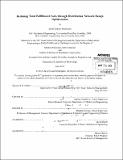Reducing total fulfillment costs through distribution network design optimization
Author(s)
Guasch Rodriguez, David
DownloadFull printable version (6.824Mb)
Other Contributors
Leaders for Global Operations Program.
Advisor
Stanley Gershwin and Stephen Graves.
Terms of use
Metadata
Show full item recordAbstract
Compared to legacy retailers, online retailers have the potential to better accommodate buyer needs by offering more service time and inventory options. One fundamental operational challenge faced by most online businesses is designing a cost effective distribution network. Based on a fixed number of locations with finite resources, companies strive for finding the cost minimizing formula for fulfilling each customer order while meeting rigorous time constraints. In practice this involves allocating specific geographies to each warehouse and defining the logistic routes serving each customer. In an attempt to address this question, a Mixed Integer Linear Programming model has been developed as a decisionmaking tool for determining the optimal carrier-destination combination at each facility. The resulting algorithm is capable of analyzing thousands of potential shipping lanes and selecting those that minimize overall shipping cost. Based on historical data from customer orders, the model consistently finds an optimal network configuration yielding operational savings on the order of 1.5%. Furthermore, the algorithm can be used to identify near-optimal solutions requiring minor tweaks on the current configuration that produce significant economic gains. This simulation tool can be used on a regular basis to adapt the outbound network to demand fluctuations. However, this phenomenon evinces the existence of a fine trade-off between economic gains and operational feasibility. For that reason, a heuristic for selecting the most robust solution is also proposed.
Description
Thesis (M.B.A.)--Massachusetts Institute of Technology, Sloan School of Management; and, (S.M.)--Massachusetts Institute of Technology, Dept. of Mechanical Engineering; in conjunction with the Leaders for Global Operations Program at MIT, 2013. Cataloged from PDF version of thesis. Includes bibliographical references (p. 56-57).
Date issued
2013Department
Leaders for Global Operations Program at MIT; Massachusetts Institute of Technology. Department of Mechanical Engineering; Sloan School of ManagementPublisher
Massachusetts Institute of Technology
Keywords
Sloan School of Management., Mechanical Engineering., Leaders for Global Operations Program.